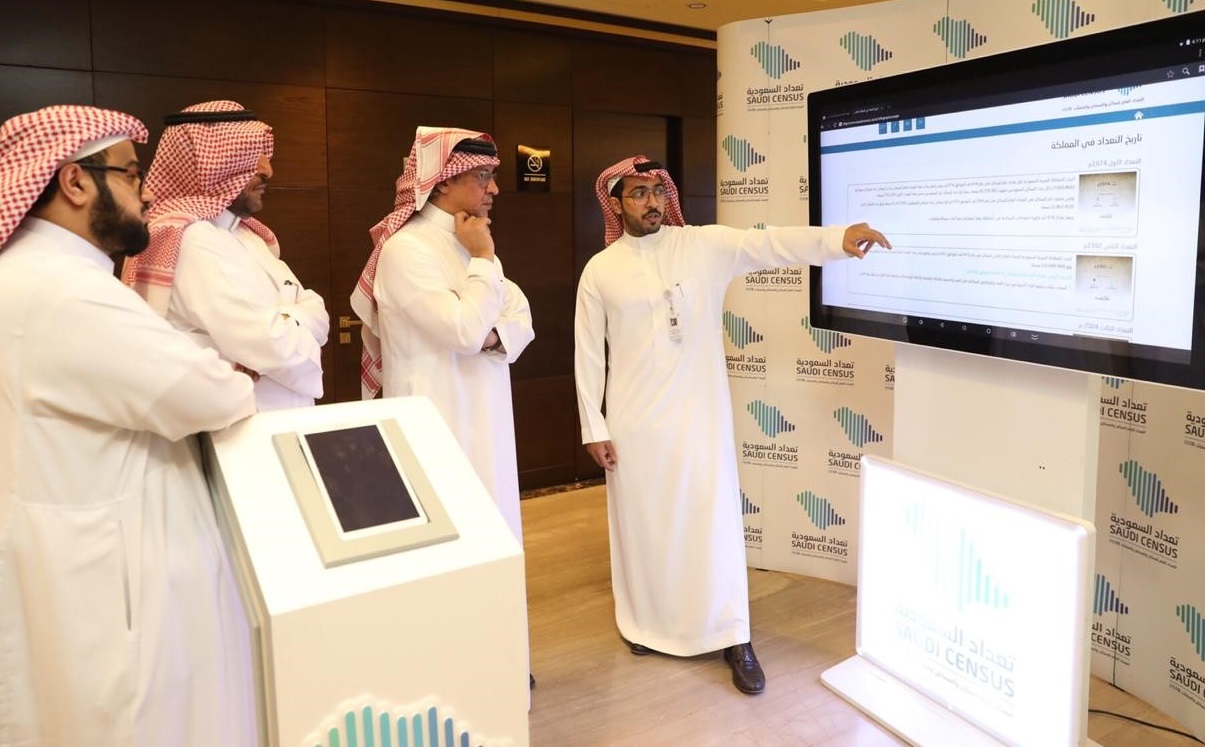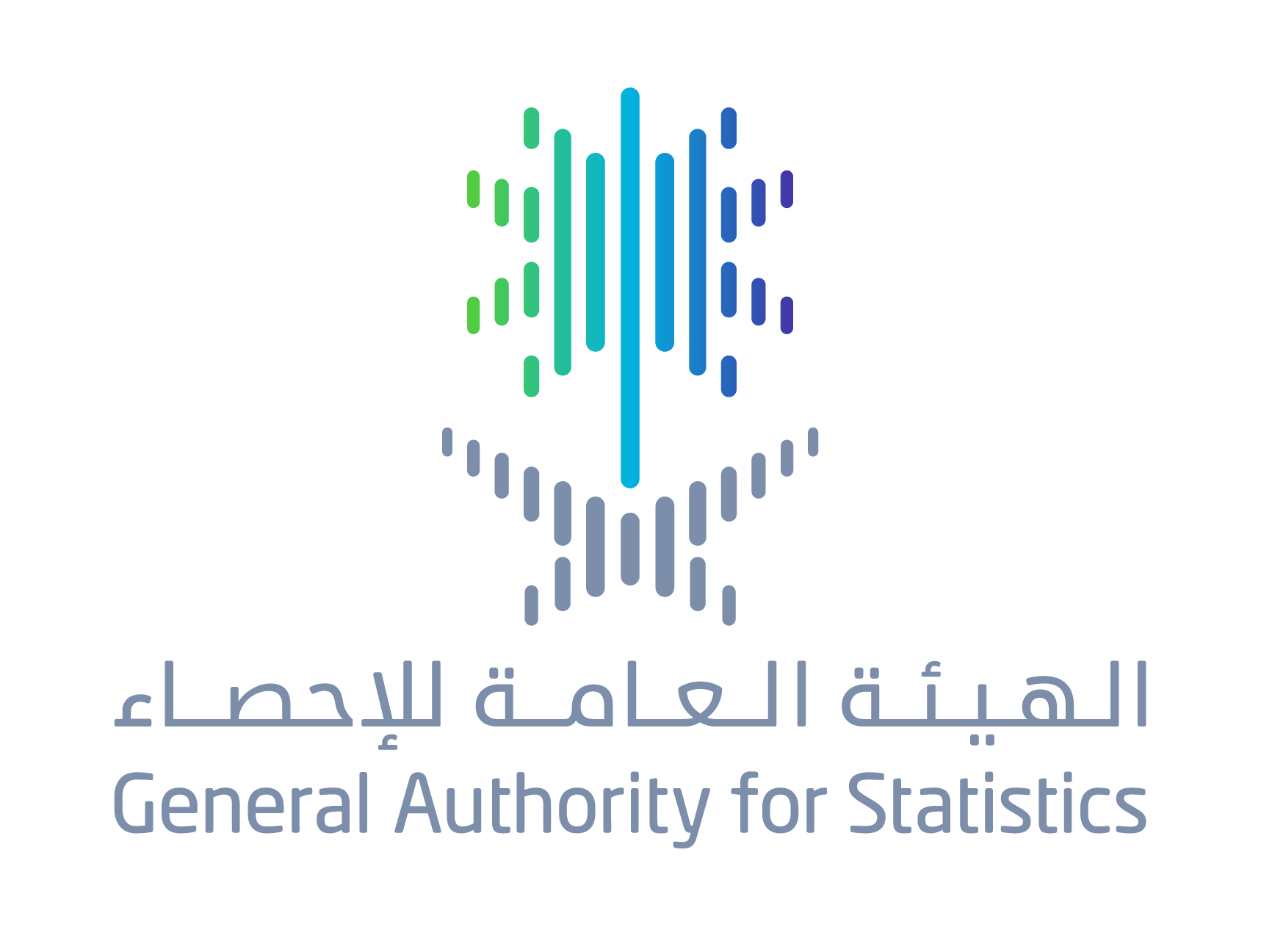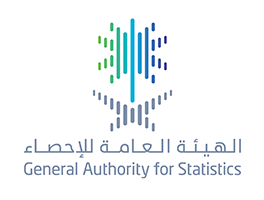
GASTAT Launches “Self-enumeration System” and e-portal for Saudi Arabia’s 2020 Census
18-06-2019
GASTAT Launches “Self-enumeration System” and e-portal for Saudi Arabia’s 2020 Census
Minister of Economy and Planning and Chairman of the Board of Directors of the General Authority for Statistics (GASTAT) Muhammad Bin Mazyad Al-Tuwaijri launched on Mondy 14/10/1440H (June 17th ,2019) the e-portal for Saudi Arabia’s 2020 census, as an awareness platform for everything related to the fifth census of housing, populations, and establishments 1440H-2020 through its official websites www.stats.gov.sa
A detailed presentation for the e-portal including its objectives as well as the preparations of the census was reviewed by HE. In fact, the e-portal of Saudi census 2020 is an official platform for all census’s news and everything related to it including announcing and publishing results, it is also a platform for spreading statistical awareness in general, deputy of GASTAT for strategic communication and clients support Taiseer AL-Mofarrej said.
The e-portal has special windows for the past four censuses and their results, it also includes windows for news and awareness content that shed light on the preparations made until now for Saudi Arabia’s 5th census, AL-Mofarrej clarified. He also added that citizens and expatriates will be able to complete the census form online through (self-enumeration system) via the website on March 2020, which is considered one of the most important modern methods for population census, as it will enable heads of the households to register all data of the family without the need for the visit of the statistical researcher to their places. This system will be used as one of the tools to collect statistical data from households in Saudi Arabia’s census 2020. On the other hand, spreading the statistical awareness among the society will lead to success of the self-enumeration experience since knowledge of technology is now considered as a feature of the Saudi society in all age groups, he added.
It is worth mentioning that the Council of Ministers has approved the implementation of the General Population and Housing Census for 2020 as the fifth census of Saudi Arabia. Tuesday’s evening, 22 Rajab 1441 (17 March 2020) will be the beginning of the actual enumeration for the 5th census of population and housing in Saudi Arabia. This date shall be the approved date for the time reference of all census works, data and information.
2020 census will provide a huge database that will be used as a reliable reference to conduct studies and researches required by the development plans and programs in Saudi Arabia, in addition to statistical data and indicators for measuring the change in the characteristics of population that occurred by time, also to make international, regional, and local comparisons, as well as reviewing and evaluating future estimates of population.
Saudi Arabia has implemented the first official census in its comprehensive sense in 1394 AH (1974). The second census was in 1413H (1992). The third census was conducted in 1425H (2004). 1431H (2010) census was the fourth census and was carried out by the Department of Statistics and Information before being transformed into the General Authority for Statistics.

Saudi Arabia concludes its participation in the first meeting of the friends of the chair group on economic statistics of the United Nations within 11 countries
12-06-2019
GASTAT provides development opportunities through big data
Saudi Arabia concludes its participation in the first meeting of the friends of the chair group on economic statistics of the United Nations within 11 countries
On Thursday May 30, 2019, Saudi Arabia, represented by the General Authority for Statistics (GASTAT), concluded its participation in the first meeting of the friends of the chair group on economic statistics of the United Nations within 11 countries, which was held at UN headquarter in New York city. The three-day meeting discussed the institutional transformation issues of national statistical bodies, in addition to the new methods, services and roles played by such statistical agencies.
GASTAT president, Dr. Fahad bin Sulaiman Altekhaifi, who led the Saudi delegation, confirmed that GASTAT 's participations with international organizations and experts of the international statistical agencies in their meetings are useful opportunities to highlight KSA's efforts in development with statistical figures and to develop statistical work according to international standards. Altekhaifi said statistical offices are challenged by changes in data gathering brought about by new technology. He added that big data could replace traditional statistical activities as an innovative way of producing official statistics or providing additional information to support the currently available official statistics, hence new indicators might be produced to support all decision makers in different developmental fields. The shift towards big data to be one of GASTAT official statistics sources reflects Saudi Arabia tendencies to benefit from the digital transformation in producing economic, social, and cultural statistics that support government bodies in accepting the rapid developmental changes which must be applied and reflected through official statistics.
GASTAT president indicated that using big data as a new (complementary or alternative) source of data creates some challenges that should be overcome by statistical entities. These challenges include the methodological aspects of data, determining data access methods, unifying statistical concepts, completing and processing data and other practices, in addition to ensuring a certain level of quality and enabling international comparisons. However, the organizational factors include other fields such as updating the organizational structure, working on statistical capacity development, establishing collaborations with the private and public data sources, and communicating with users.
Altekhaifi mentioned that the national statistical agencies must overcome these challenges to guarantee the usefulness of big data in the production of official statistics, especially for databases, computing and digitization. Statistical entities need to adopt national statistical strategies that deal with plans, strategies, implementation methods and development mechanisms in the national statistical environment. In addition, they need to enhance coordination and partnerships between the national statistical agencies and the different sources of data, whether governmental or private. However, all databases of government and private statistical entities must be electronically linked, while maintaining the confidentiality and privacy of data when exchanging data. Furthermore, statistical indicators definitions, concepts, and methodologies must be unified among all partners to avoid misunderstandings of statistics that result from the use of different concepts and methodology. This includes the use of official international statistical classifications such as ISIC 4 by all partners from the public and private sectors to facilitate work on databases and get coordinated and comparable data that are ready for all statistical purposes. Moreover, it is important for all statistical entities to have a road map through which they can use big data to provide official data.
GASTAT has reviewed all Saudi Arabia’ efforts to benefit from big data by approving the National Strategy for Statistical Development, electronic linkage projects, and international classifications. In addition to unifying the definitions and methodologies, and encouraging the initiatives of digital transformation in all public and private sectors.
It is worth mentioning that many international experts in the statistical and economic fields have participated in the discussions of the first meeting of the friends of the chair group on economic statistics of the United Nations. Topics discussed included the future of economic statistics within the Sustainable Development Goals from the perspectives of the international organizations and the national statistical entities. They also included digital infrastructure, and maintaining an interactive economic system, in addition to discussing a number of experiments on the institutional transformation of the national statistical offices, and methods of using data sources.

GASTAT Releases Results of Umrah Statistics Bulletin (2018)
14-05-2019
GASTAT Releases Results of Umrah Statistics Bulletin (2018)
On Tuesday 2nd of Ramadan, 1440H corresponding May 7, 2019, General Authority for Statistics (GASTAT) released the results of Umrah Statistics Bulletin (2018). The report contains a number of Umrah-related indicators and results which have been taken from Umrah Survey (domestic Umrah performers), and the registered- based data of the Ministry of Hajj and Umrah (foreign Umrah performers).
The total number of Umrah performers reached (18,311,111) performers, (6,765,614) of whom are from outside Saudi Arabia as showed in the registered- based data of the Ministry of Hajj and Umrah. On the other hand, the total number of domestic Umrah performers (Saudis and non-Saudis) hit (11,545,497) performers. The percentage of Umrah performers for Saudis as well as non-Saudis coming from inside Saudi Arabia recorded (46.17%) and (53.83%), respectively, according to the Umrah Statistics Bulletin’s results.
Vast majority of domestic Umrah performers (Saudis and residents) carry out Umrah within one day, with a percentage of (67.5%) out of the total number of Umrah times they performed during 2018. However, they prefer to perform Umrah during Ramadan, where their percentage accounted for (59%), the Umrah Survey’s results showed.
King Abdulaziz International Airport in Jeddah registered the highest percentage regarding foreign Umrah performers with (62%), while the percentage of Umrah performers coming through Prince Mohammad bin Abdulaziz International Airport in Medina was (29.31%).
It is worth mentioning that all the Umrah Survey’s data are available on GASTAT’s website www.stats.gov.sa, to serve researchers and those who are interested in such data, and to provide decision makers with detailed field results.

GASTAT Releases the Results of the Household’s Income and Expenditure Survey (2018)
09-05-2019
Issued every five years and considered the second most important statistical product, and its results contribute to the calculation of several social and economic indicators
GASTAT Releases the Results of the Household’s Income and Expenditure Survey (2018)
On Wednesday Sha’aban 26th, 1440 H (May 1st, 2019), the General Authority for Statistics (GASTAT) announced the results of the Household’s Income and Expenditure Survey (2018) in a press conference held in GASTAT’s headquarters in Riyadh city. At the beginning of the conference, HE the President of GASTAT, Dr Fahad Bin Sulaiman Altekhaifi, valued the main role of the households selected in the survey sample in reaching statistical results of high importance in a number of developmental directions. The Household’s Income and Expenditure Survey is one of the most important statistical household products of statistical agencies in all countries. The results of this survey provide the necessary statistical data for the development of economic and social development programs and plans aimed at achieving the well-being and progress of the communities. The data of this survey are the basis of many studies and research conducted by government agencies and international organizations. The statistical agencies classify it as one of the field surveys (households sampling) in social statistics, and provide data on patterns of expenditure in society and show the impact of demographic, social and economic factors on families.
According to international recommendations, the Household’s Income and Expenditure Survey is carried out every 5 years. It has been implemented in Saudi Arabia in 1970, 1977, 1980, 1985, 1999, 2007, and 2013). The collection of data takes (five quarters of two calendar years). The current survey was carried out within 13 months starting from February 28th, 2017 until March 31st, 2018.
HE explained that the length of data collection is due to the fact that many of the variables of the study are vulnerable to different seasons during the months or seasons of the year. There are goods and services people spend on during certain months of the year more than others. The household interview in the survey does not end with one field visit, but needs a number of visits to follow-up with the household during the period specified, to collect all the required data.
Altekhaifi added that all these factors necessitate the follow-up of field implementation for more than a year, including all seasons to measure the change in expenditure patterns and levels due to seasonal, occasional and periodic changes, which can be measured accurately in a relatively long period of time compared to the rest of the household surveys conducted by GASTAT throughout the year.
The president of GASTAT confirmed that the Authority has fulfilled its obligations in implementing the international standards adopted for indicators of household income and expenditure in order to enable international organizations to conduct a periodic comparison between all countries. The results of the survey, which were announced today, are the basis for a number of socio-economic statistical products. The results of the survey provide the data of qualitative weights used in the preparation of the consumer price index. Through this survey, the basket of goods and services is updated, which is a relatively fixed collection of consumer goods and services which are estimated on an annual basis. This basket is used to track inflation in each country. The goods of the basket are periodically adjusted based on the results of the Household’s Income and Expenditure Survey to take into account changes in consumer habits. The basket of goods and services is used as a basis to calculate the Consumer Price Index and wholesale prices.
The results of this survey also provide data on the patterns of expenditure in society, the impact of demographic, social and economic factors on the household, provide data on household expenditure on goods and services as a component of the final expenditure in GDP, and provide data necessary for national accounts related to the final consumption and household sector income.
He added that the results of the survey contribute mainly in identifying patterns of expenditure in society and indicating the impact of demographic, social and economic factors on them. It also provides policy and decision makers with all statistics on Saudi and non-Saudi household expenditure on consumer goods such as food, drinks, clothes, as well as non-consumer goods, such as remittances and capital goods such as purchasing of buildings, lands, stocks, donations, etc. Through these statistics, weights are provided showing the importance of consumer expenditure items, and it can be used to identify levels of income distribution and expenditure levels, by category (low, medium, high).
On the other hand, GASTAT confirmed that the results of this survey play a major role in supporting projects related to income and expenditure of households such as social protection, social development and family affairs projects. It also contributes to the development of important social indicators such as indicators of sustainable development goals, human development indicators and other international indicators.
The results of the Household’s Income and Expenditure Survey (2018) showed that the average monthly income of the household reached 11,984 SAR (eleven thousand nine hundred and eighty-four riyals), while the average monthly income of the Saudi household reached 14,823 SAR (fourteen thousand eight hundred and twenty-three riyals).
The results of the survey also showed that the average monthly income of "individuals with income" reached 6,346 SAR (six thousand three hundred and forty-six riyals), while the average monthly income of "Saudi individuals with income" reached 7,940 SAR (seven thousand nine hundred and forty riyals).
In terms of expenditure, the average monthly expenditure of households in Saudi Arabia reached 12,818 SAR (twelve thousand eight hundred and eighteen riyals), while the average monthly expenditure of the Saudi household reached 16,125 SAR (sixteen thousand and one hundred and twenty-five riyals). The average monthly “consumption” expenditure reached 11,728 SAR (eleven thousand seven hundred and twenty-eight riyals) , While the monthly “consumption” expenditure of the Saudi household reached 14,584 SAR (fourteen thousand five hundred and eighty-four riyals).
During the press conference, GASTAT clarified that the Authority made a number of measures to ensure the quality of the data. GASTAT used the method of the direct visit to the household, used tablets to complete survey questionnaire data based on the specific time frame, and applied (data auditing rules) to ensure consistency, accuracy and logicality of the data on the survey form (electronic rules that detect the discrepancy of answers). They have been built by linking the logical relationship between the answers to the questionnaire and its variables so that the field researcher and the observer can detect any error directly through the form during the collection of data from the head of the household. These programmed rules do not allow errors to be passed if the answer is inconsistent with information, or with another answer in the form. The data was verified by reviewing the collected data. All the work areas were subjected to a process of monitoring and reviewing from the data quality room at the headquarters of GASTAT. A sample of households were contacted by telephone and asked some questions in the questionnaire to verify the integrity of the researcher data, obtain lost data that have not been received yet if any, and validated the location where the questionnaire have been completed by matching the coordinates with the coordinates recorded in the sample file.
On the other hand, GASTAT published the results of the Household’s Income and Expenditure Survey (2018) on its official website www.stats.gov.sa. The result’s data has been provided in the form of open templates to be utilized in studies and analysis. It is worth mentioning that GASTAT intends to carry out the survey every three years from 2021 in accordance with the local, regional and international requirements of the data.
